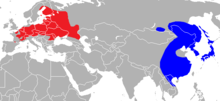| Common raccoon dog | |
|---|---|

| |
| In Ukraine | |
| Scientific classification | |
| Domain: | Eukaryota |
| Kingdom: | Animalia |
| Phylum: | Chordata |
| Class: | Mammalia |
| Order: | Carnivora |
| Family: | Canidae |
| Genus: | Nyctereutes |
| Species: | N. procyonoides
|
| Binomial name | |
| Nyctereutes procyonoides (Gray, 1834)
| |

| |
| Common raccoon dog range Blue – native area (including range of Japanese raccoon dog) Red – area of introduction | |
| Synonyms | |
| |
The common raccoon dog (Nyctereutes procyonoides), also called the Chinese or Asian raccoon dog to distinguish it from the Japanese raccoon dog, is a small, heavy-set, fox-like canid native to East Asia. Named for its raccoon-like face markings, it is most closely related to foxes. Common raccoon dogs feed on many animals and plant matter, and are unusual among canids (dogs, foxes, and other members of the family Canidae) in that they hibernate during cold winters and can climb trees. They are widespread in their native range, and are invasive in Europe where they were introduced for the fur trade. The similar Japanese raccoon dog (Nyctereutes viverrinus, the tanuki), native to Japan, is the only other living member of the genus Nyctereutes.[2] Other names for the common raccoon dog include mangut (its Evenki name),[3] and neoguri (its Korean name).
The common raccoon dog is named for the resemblance of its masked face to that of the North American common raccoon (Procyon lotor). The closest relatives of the common raccoon dogs are the true foxes, not the raccoon, which is one of the musteloids, and not closely related. Among the Canidae, the common raccoon dog shares the habit of regularly climbing trees only with the North American gray fox, which is neither a true fox nor a close relative of the common raccoon dog.[4][5][6][7]
Due to the fur trade, the common raccoon dog has been widely introduced in Europe, where it has been treated as a potentially hazardous invasive species.[8] In Scandinavia, it is called "marten-dog" (Swedish: mårdhund, Norwegian and Danish: mårhund).[8] In Europe, since 2019, the common raccoon dog has been included on the list of Invasive Alien Species of Union concern (the Union list).[9] This implies that this species cannot be imported, bred, transported, commercialized, or intentionally released into the environment in the whole of the European Union.[10]
- ^ Kauhala, K.; Saeki, M. (2016). "Nyctereutes procyonoides". IUCN Red List of Threatened Species. 2016: e.T14925A85658776. doi:10.2305/IUCN.UK.2016-1.RLTS.T14925A85658776.en. Retrieved 2022-02-19.
- ^ Kim, Sang-In; Oshida, Tatsuo; Lee, Hang; Min, Mi-Sook; Kimura, Junpei (2015). "Evolutionary and biogeographical implications of variation in skull morphology of raccoon dogs (Nyctereutes procyonoides, Mammalia: Carnivora)". Biological Journal of the Linnean Society. 116 (4): 856–872. doi:10.1111/bij.12629. ISSN 1095-8312.
- ^ Cite error: The named reference
sovietwas invoked but never defined (see the help page). - ^ Cite error: The named reference
canidswas invoked but never defined (see the help page). - ^ Macdonald, David W.; Sillero-Zubir, Claudio (24 June 2004). The Biology and Conservation of Wild Canids. Oxford University Press. ISBN 9780191523359. Archived from the original on 2023-03-17. Retrieved 2016-02-16.
- ^ Ikeda, Hiroshi (August 1986). "Old, new tricks: Asia's raccoon, a venerable member of the canid family is pushing into new frontiers". Natural History. 95 (8): 40, 44.
- ^ "Raccoon Dog, Tanuki". Waza.org. World Association of Zoos and Aquariums. Archived from the original on 2015-04-10. Retrieved 2015-04-09.
- ^ a b Sweden says open season on raccoon dogs Archived 2009-09-05 at the Wayback Machine. UPI.com (2009-09-04). Retrieved on 2011-01-27.
- ^ "List of Invasive Alien Species of Union concern - Environment - European Commission". ec.europa.eu. Archived from the original on 2019-08-19. Retrieved 2021-07-27.
- ^ "REGULATION (EU) No 1143/2014 of the European parliament and of the council of 22 October 2014 on the prevention and management of the introduction and spread of invasive alien species". Archived from the original on 2017-03-03.
